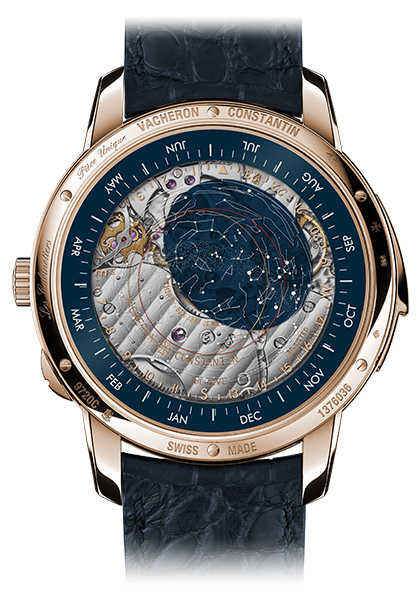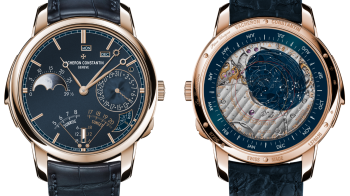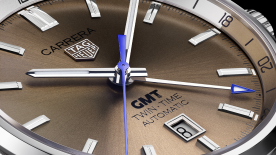As part of the range poetically named "La Musique du Temps®", which includes a collection of chiming watches – all one-of-a-kind collector’s pieces –, this new creation is based first and foremost on a minute repeater which determined the construction of the entire calibre. The starting point was the Manufacture 1731 movement, due to its slimness for a minute repeater mechanism. At just 3.90 mm thick, the 1731 calibre also has an impressive 60-hour power reserve and a sound quality, thanks in particular to the development of an entirely silent flying strike governor. This movement has therefore been reworked to accommodate the astronomical complications that make this timepiece an exceptional watch. With the new 1731 M820 calibre, this timepiece is thus equipped with 19 complications – a feat in itself – housed in a space barely 7.84 millimetres thick, without straying from the spirit of the ultra-thin base movement. One of the great challenges was to index the running equation of time to the minute repeater while maintaining extreme slenderness.
Perpetual calendar and solar time
This watch is equipped with a perpetual calendar that is expressed on the blue opaline dial. The date is indicated by a serpentine hand in a snailed counter at 3 o'clock for the sake of legibility. The days, months and leap years are displayed in windows between 12 and 2 o'clock. The date is indicated by the precision moon phases and age, but also the day / night indication which is coaxial to the moon phases, a logical and lyrical complement to the perpetual calendar. The lower part of the dial is occupied by the pointer-type display of sunrise and sunset times, complemented by a linear indication of the length of day and night. A 4 o'clock aperture also reveals a disc bearing the signs of the zodiac, seasons, solstices and equinoxes.
As heralded by the latter functions, this piece is first and foremost an astronomical watch which, in addition to the civil time indicated by the two central hands, also displays the particularities of solar time. Since the Earth's path around the Sun describes a trajectory that is not circular but instead elliptical, and given that the Earth's axis is inclined at 24° to the plane of its orbit, the time between two solar zenith passages is not the same throughout the year. This difference between the solar (true) day and the civil (average/mean) 24-hour day ranges from -16 to +14 minutes depending on the time of the year, coinciding only four times in 12 months.
Known as the equation of time, or time correction in astronomical parlance, this information has long fascinated watchmakers. The fact that these variations are rigorously identical from one year to the next makes it possible to programme them mechanically via an annual cam that controls the display of this time differential. For this timepiece, the company's master watchmakers have chosen the rarer and more complex solution of a running equation of time. This consists in also displaying solar time by means of a central minutes hand, in this instance symbolically serrated, and thus enables instantaneous reading of both civil and solar time.

Sidereal time
An astronomical watch according to Vacheron Constantin's master watchmakers would not deserve its name without an indication of sidereal time. This is precisely what can be viewed on the back of this timepiece, with a sky chart ingeniously formed by two superimposed sapphire discs. Taking a fixed star in the sky as a reference point, the time it takes the Earth to complete a full 360° revolution, or sidereal day, is exactly 23 hours, 56 minutes and 4 seconds. Since the Earth both spins on its axis and revolves around the sun, it takes about four minutes less than a calendar day to return to its point of departure in relation to the given star. On this model, the first lower mobile disc is rimmed by a sidereal time scale punctuated by the cardinal points, which thus rotates in step with sidereal time.
Still on the same disc, an off-centred blue ellipse serves as a transparent indicator of the constellations of the celestial vault, which are positionned on the fixed upper disc. This mechanical ballet thus reveals the vision of the sky in motion as seen from a given point on Earth. This same second disc also bears a white ellipse for the celestial equator and a red ellipse for the ecliptic. While the first is a projection of the equator onto the celestial sphere that takes into account the Earth's approximately 24° inclination, the second represents – from a heliocentric point of view – the plane of the Earth's orbit serving as a reference for celestial coordinates. Finally, one notes an intense blue dial bearing the months of the year.
The difference between the sidereal day and the mean or average day means that the movable lower disc will accelerate daily by some four minutes in relation to the fixed outer disc, so as to indicate the current month at exactly midnight by means of a yellow arrow.
Housed in a pink gold case measuring 45 mm in diameter and barely 12.54 mm thick, designed to accommodate the sky chart corrector and the minute repeater slide on the case middle, this calibre is one of the very few movements to offer simultaneously a minutes repeater and the civil, solar and sidereal time.. This level of complexity is matched by the finishing of this timepiece, including the Côtes de Genève that can be be admired through the transparency of a movement that appears to be floating in the stars. A midnight blue alligator leather strap with pin buckle rounds off the elegance of this captivatingly complex timepiece.







